Comparison of Seasonal and Diurnal Concentration Profiles of BVOCs in Coniferous and Deciduous Forests
Abstract
:1. Introduction
2. Materials and Methods
2.1. Sampling Sites
2.2. Sampling
2.3. Analytical Procedure
2.4. Statistical Analysis
3. Results
3.1. Effectiveness of the Ozone Scrubber
3.2. Seasonal Variation of Terpenes
3.3. Diurnal Variation of Terpenes
3.4. Correlation of Emissions with Meteorological Parameters
4. Summary
Author Contributions
Funding
Institutional Review Board Statement
Informed Consent Statement
Data Availability Statement
Acknowledgments
Conflicts of Interest
References
- Peñuelas, J.; Staudt, M. BVOCs and global change. Trends Plant Sci. 2010, 15, 133–144. [Google Scholar] [CrossRef] [PubMed]
- Schwantes, R.H.; Emmons, L.K.; Orlando, J.J.; Barth, M.C.; Tyndall, G.S.; Hall, S.R.; Ullmann, K.; St. Clair, J.M.; Blake, D.R.; Wisthaler, A.; et al. Comprehensive isoprene and terpene gas-phase chemistry improves simulated surface ozone in the southeastern US. Atmos. Chem. Phys. 2020, 20, 3739–3776. [Google Scholar] [CrossRef]
- Salvador, C.M.; Chou, C.C.K.; Ho, T.-T.; Tsai, C.-Y.; Tsao, T.-M.; Tsai, M.-J.; Su, T.-C. Contribution of Terpenes to Ozone Formation and Secondary Organic Aerosols in a Subtropical Forest Impacted by Urban Pollution. Atmosphere 2020, 11, 1232. [Google Scholar] [CrossRef]
- Mutzel, A.; Rodigast, M.; Iinuma, Y.; Böge, O.; Herrmann, H. Monoterpene SOA—Contribution of first-generation oxidation products to formation and chemical composition. Atmos. Environ. 2016, 130, 136–144. [Google Scholar] [CrossRef]
- Mu, Z.; Llusia, J.; Zeng, J.; Zhang, Y.; Asensio, D.; Yang, K.; Yi, Z.; Wang, X.; Penuelas, J. An Overview of the Isoprenoid Emissions from Tropical Plant Species. Front. Plant Sci. 2022, 13, 833030. [Google Scholar] [CrossRef]
- Lun, X.; Lin, Y.; Chai, F.; Fan, C.; Li, H.; Liu, J. Reviews of emission of biogenic volatile organic compounds (BVOCs) in Asia. J. Environ. Sci. 2020, 95, 266–277. [Google Scholar] [CrossRef]
- Ferracci, V.; Bolas, C.G.; Freshwater, R.A.; Staniaszek, Z.; King, T.; Jaars, K.; Otu-Larbi, F.; Beale, J.; Malhi, Y.; Waine, T.W.; et al. Continuous Isoprene Measurements in a UK Temperate Forest for a Whole Growing Season: Effects of Drought Stress during the 2018 Heatwave. Geophys. Res. Lett. 2020, 47, e2020GL088885. [Google Scholar] [CrossRef]
- Antonelli, M.; Donelli, D.; Barbieri, G.; Valussi, M.; Maggini, V.; Firenzuoli, F. Forest Volatile Organic Compounds and Their Effects on Human Health: A State-of-the-Art Review. Int. J. Environ. Res. Public Health. 2020, 17, 6506. [Google Scholar] [CrossRef]
- Kopaczyk, J.M.; Warguła, J.; Jelonek, T. The variability of terpenes in conifers under developmental and environmental stimuli. Environ. Exp. Bot. 2020, 180, 104197. [Google Scholar] [CrossRef]
- Lerdau, M.; Guenther, A.; Monson, R. Plant Production and Emission of Volatile Organic Compounds. BioScience 1997, 47, 373–383. [Google Scholar] [CrossRef]
- McGlynn, D.F.; Frazier, G.; Barry, L.E.R.; Lerdau, M.T.; Pusede, S.E.; Isaacman-VanWertz, G. Minor contributions of daytime monoterpenes are major contributors to atmospheric reactivity. Biogeosciences 2023, 20, 45–55. [Google Scholar] [CrossRef]
- Atkinson, R.; Arey, J. Gas-phase tropospheric chemistry of biogenic volatile organic compounds: A review. Atmos. Environ. 2003, 37, 197–219. [Google Scholar] [CrossRef]
- Guenther, A. Biological and Chemical Diversity of Biogenic Volatile Organic Emissions into the Atmosphere. ISRN Atmos. Sci. 2013, 2013, 786290. [Google Scholar] [CrossRef]
- Meneguzzo, F.; Albanese, L.; Bartolini, G.; Zabini, F. Temporal and Spatial Variability of Volatile Organic Compounds in the Forest Atmosphere. Int. J. Environ. Res. Public Health 2019, 16, 4915. [Google Scholar] [CrossRef]
- McGlynn, D.F.; Barry, L.E.R.; Lerdau, M.T.; Pusede, S.E.; Isaacman-VanWertz, G. Measurement report: Variability in the composition of biogenic volatile organic compounds in a Southeastern US forest and their role in atmospheric reactivity. Atmos. Chem. Phys. 2021, 21, 15755–15770. [Google Scholar] [CrossRef]
- Hakola, H.; Taipale, D.; Praplan, A.; Schallhart, S.; Thomas, S.; Tykkä, T.; Helin, A.; Bäck, J.; Hellén, H. High variations of BVOC emissions from Norway spruce in boreal forests. Atmos. Chem. Phys. Discuss. 2022, 2022, 1–29. [Google Scholar] [CrossRef]
- Hakola, H.; Hellén, H.; Hemmilä, M.; Rinne, J.; Kulmala, M. In situ measurements of volatile organic compounds in a boreal forest. Atmos. Chem. Phys. 2012, 12, 11665–11678. [Google Scholar] [CrossRef]
- Yu, H.; Guenther, A.; Gu, D.; Warneke, C.; Geron, C.; Goldstein, A.; Graus, M.; Karl, T.; Kaser, L.; Misztal, P.; et al. Airborne measurements of isoprene and monoterpene emissions from southeastern U.S. forests. Sci. Total Environ. 2017, 595, 149–158. [Google Scholar] [CrossRef]
- Lee, J.H.; Batterman, S.A.; Jia, C.; Chernyak, S. Ozone artifacts and carbonyl measurements using Tenax GR, Tenax TA, Carbopack B, and Carbopack X adsorbents. J. Air Waste Manag. Assoc. 2006, 56, 1503–1517. [Google Scholar] [CrossRef]
- Helmig, D. Ozone removal techniques in the sampling of atmospheric volatile organic trace gases. Atmos. Environ. 1997, 31, 3635–3651. [Google Scholar] [CrossRef]
- Fick, J.; Pommer, L.; Andersson, B.; Nilsson, C. Ozone Removal in the Sampling of Parts per Billion Levels of Terpenoid Compounds: An Evaluation of Different Scrubber Materials. Environ. Sci. Technol. 2001, 35, 1458–1462. [Google Scholar] [CrossRef]
- Pollmann, J.; Ortega, J.; Helmig, D. Analysis of Atmospheric Sesquiterpenes: Sampling Losses and Mitigation of Ozone Interferences. Environ. Sci. Technol. 2005, 39, 9620–9629. [Google Scholar] [CrossRef]
- Mermet, K.; Sauvage, S.; Dusanter, S.; Salameh, T.; Léonardis, T.; Flaud, P.-M.; Perraudin, É.; Villenave, É.; Locoge, N. Optimization of a gas chromatographic unit for measuring biogenic volatile organic compounds in ambient air. Atmos. Meas. Tech. 2019, 12, 6153–6171. [Google Scholar] [CrossRef]
- Kootstra, P.R.; Herbold, H.A. Automated solid-phase extraction and coupled-column reversed-phase liquid chromatography for the trace-level determination of low-molecular-mass carbonyl compounds in air. J. Chromatogr. A 1995, 697, 203–211. [Google Scholar] [CrossRef]
- Greenberg, J.P.; Lee, B.; Helmig, D.; Zimmerman, P.R. Fully automated gas chromatograph-flame ionization detector system for the in situ determination of atmospheric nonmethane hydrocarbons at low parts per trillion concentration. J. Chromatogr. A 1994, 676, 389–398. [Google Scholar] [CrossRef]
- Helmig, D.; Greenberg, J. Artifact formation from the use of potassium-iodide-based ozone traps during atmospheric sampling of trace organic gases. J. High Resolut. Chrom. 1995, 18, 15–18. [Google Scholar] [CrossRef]
- Helin, A.; Hakola, H.; Hellén, H. Optimisation of a thermal desorption–gas chromatography–mass spectrometry method for the analysis of monoterpenes, sesquiterpenes and diterpenes. Atmos. Meas. Tech. 2020, 13, 3543–3560. [Google Scholar] [CrossRef]
- Mayer, T.; Cämmerer, M.; Borsdorf, H. A versatile and compact reference gas generator for calibration of ion mobility spectrometers. Int. J. Ion Mobil. Spectrom. 2020, 23, 51–60. [Google Scholar] [CrossRef]
- Malik, T.G.; Gajbhiye, T.; Pandey, S.K. Plant specific emission pattern of biogenic volatile organic compounds (BVOCs) from common plant species of Central India. Environ. Monit. Assess. 2018, 190, 631. [Google Scholar] [CrossRef]
- Holzke, C.; Dindorf, T.; Kesselmeier, J.; Kuhn, U.; Koppmann, R. Terpene emissions from European beech (shape Fagus sylvatica L.): Pattern and Emission Behaviour Over two Vegetation Periods. J. Atmos. Chem. 2006, 55, 81–102. [Google Scholar] [CrossRef]
- Ghirardo, A.; Koch, K.; Taipale, R.; Zimmer, I.; Schnitzler, J.P.; Rinne, J. Determination of de novo and pool emissions of terpenes from four common boreal/alpine trees by 13CO2 labelling and PTR-MS analysis. Plant Cell Environ. 2010, 33, 781–792. [Google Scholar] [CrossRef] [PubMed]
- Vettikkat, L.; Miettinen, P.; Buchholz, A.; Rantala, P.; Yu, H.; Schallhart, S.; Petäjä, T.; Seco, R.; Männistö, E.; Kulmala, M.; et al. High emission rates and strong temperature response make boreal wetlands a large source of isoprene and terpenes. Atmos. Chem. Phys. 2023, 23, 2683–2698. [Google Scholar] [CrossRef]
- Niinemets, Ü.; Loreto, F.; Reichstein, M. Physiological and physicochemical controls on foliar volatile organic compound emissions. Trends Plant Sci. 2004, 9, 180–186. [Google Scholar] [CrossRef] [PubMed]
- Yan, Z.; Wang, S.; Ma, D.; Liu, B.; Lin, H.; Li, S. Meteorological Factors Affecting Pan Evaporation in the Haihe River Basin, China. Water 2019, 11, 317. [Google Scholar] [CrossRef]

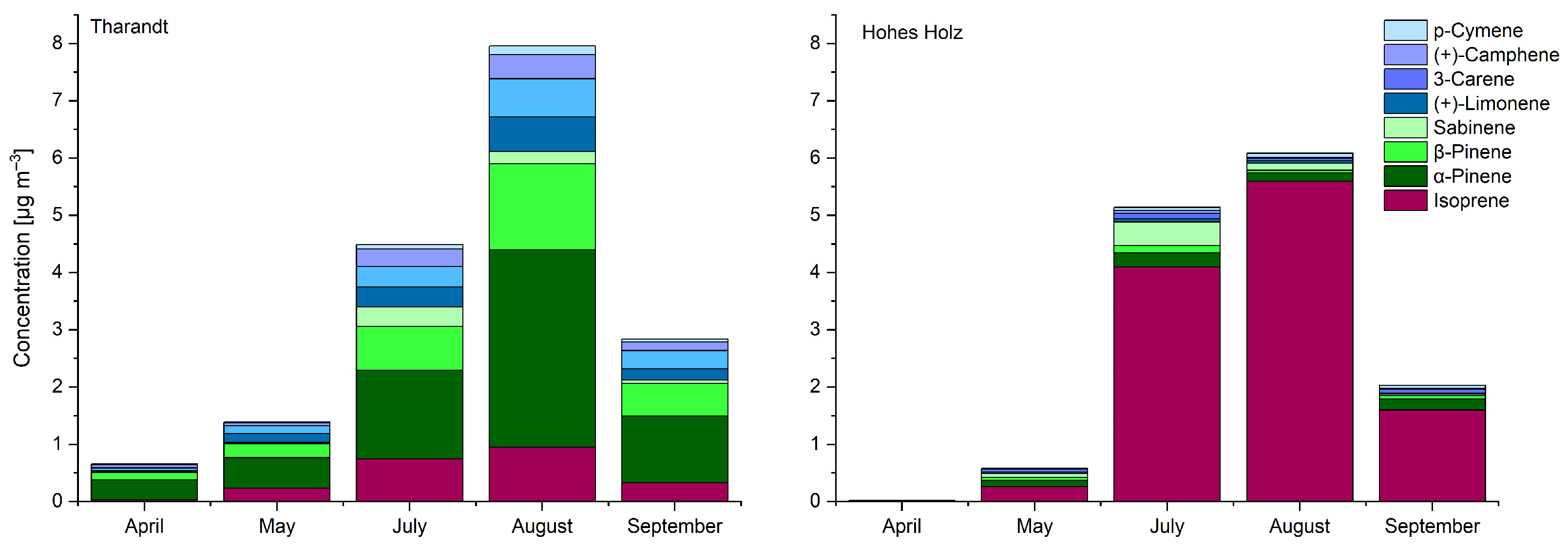

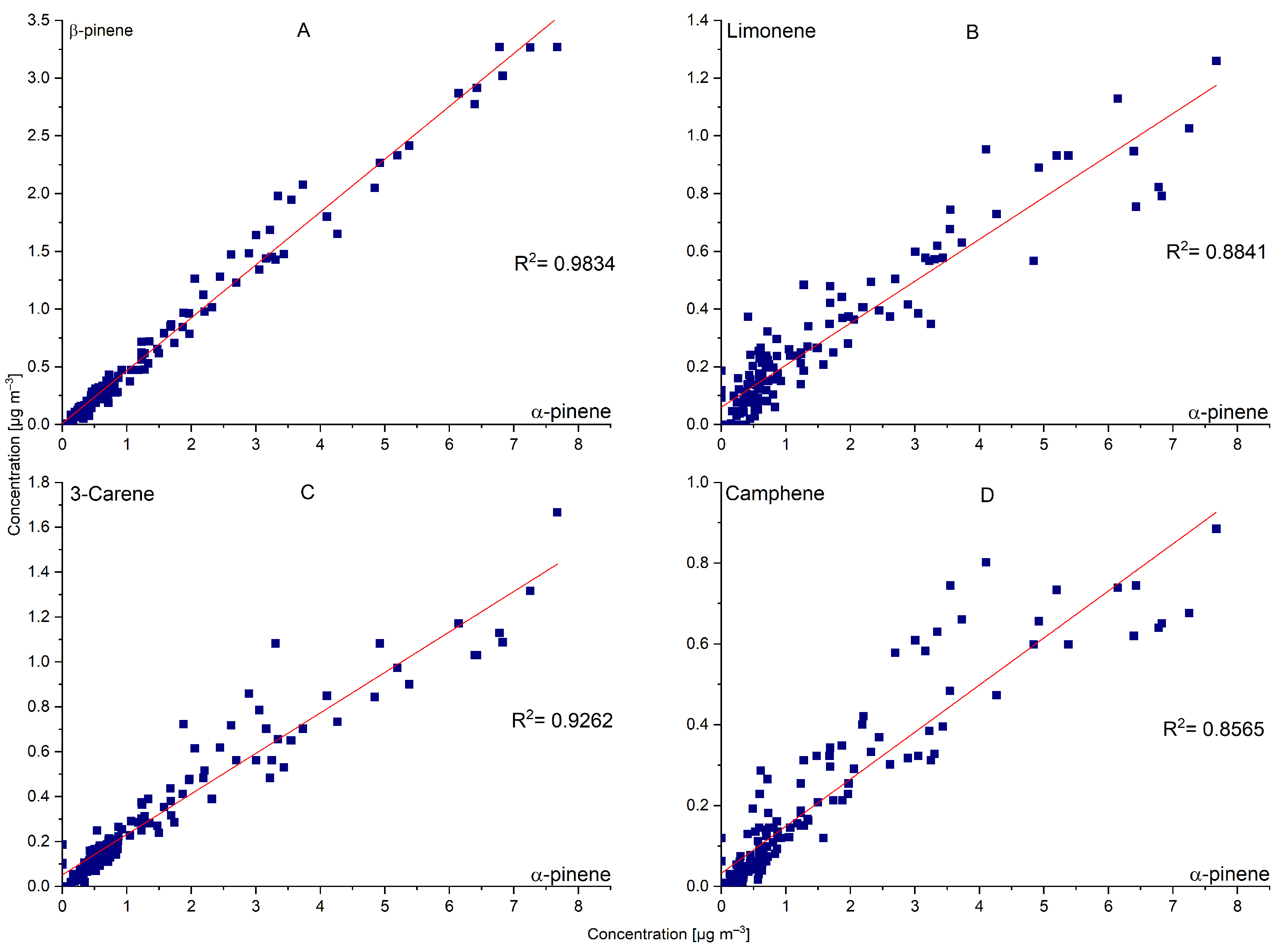
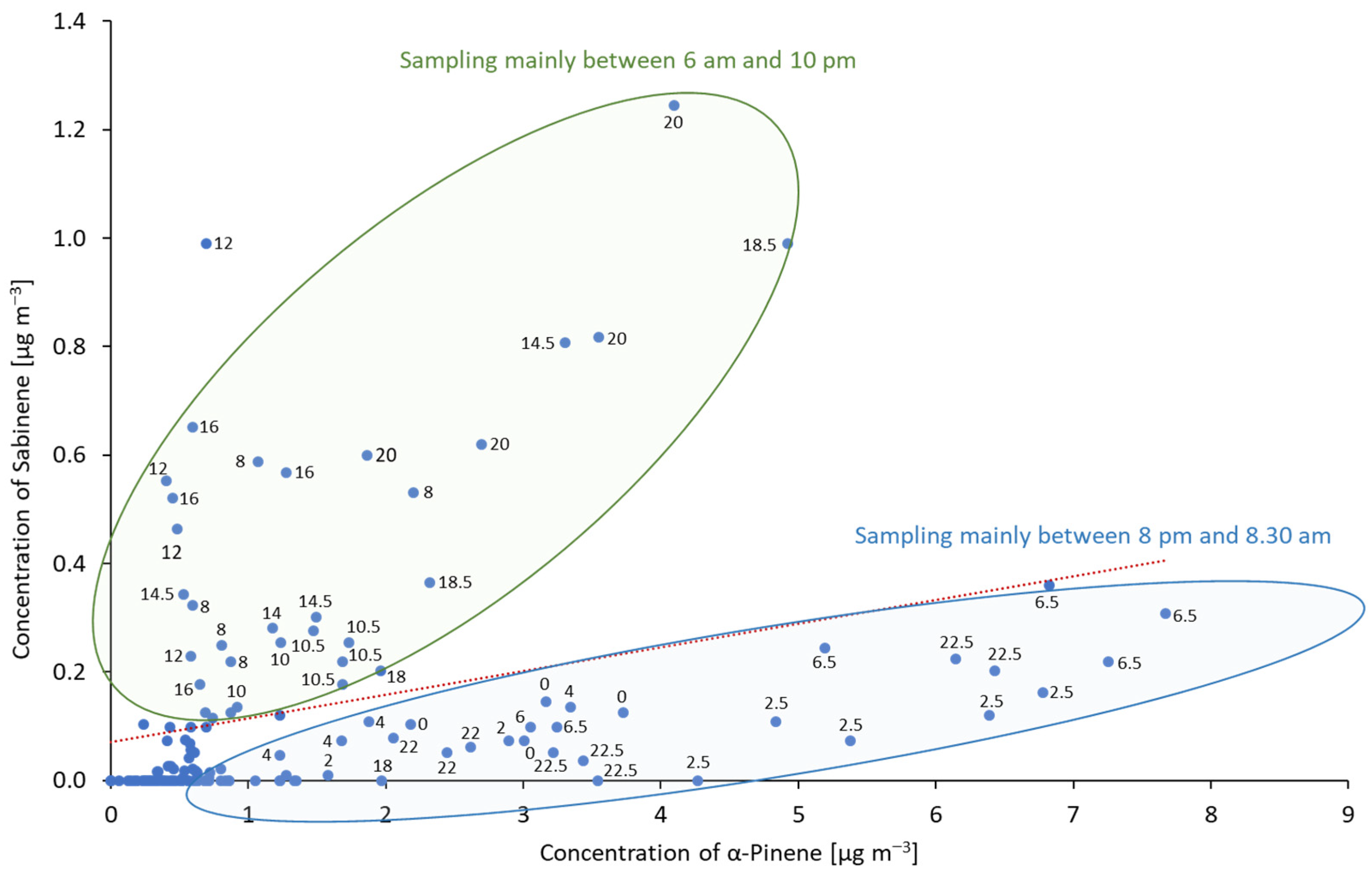
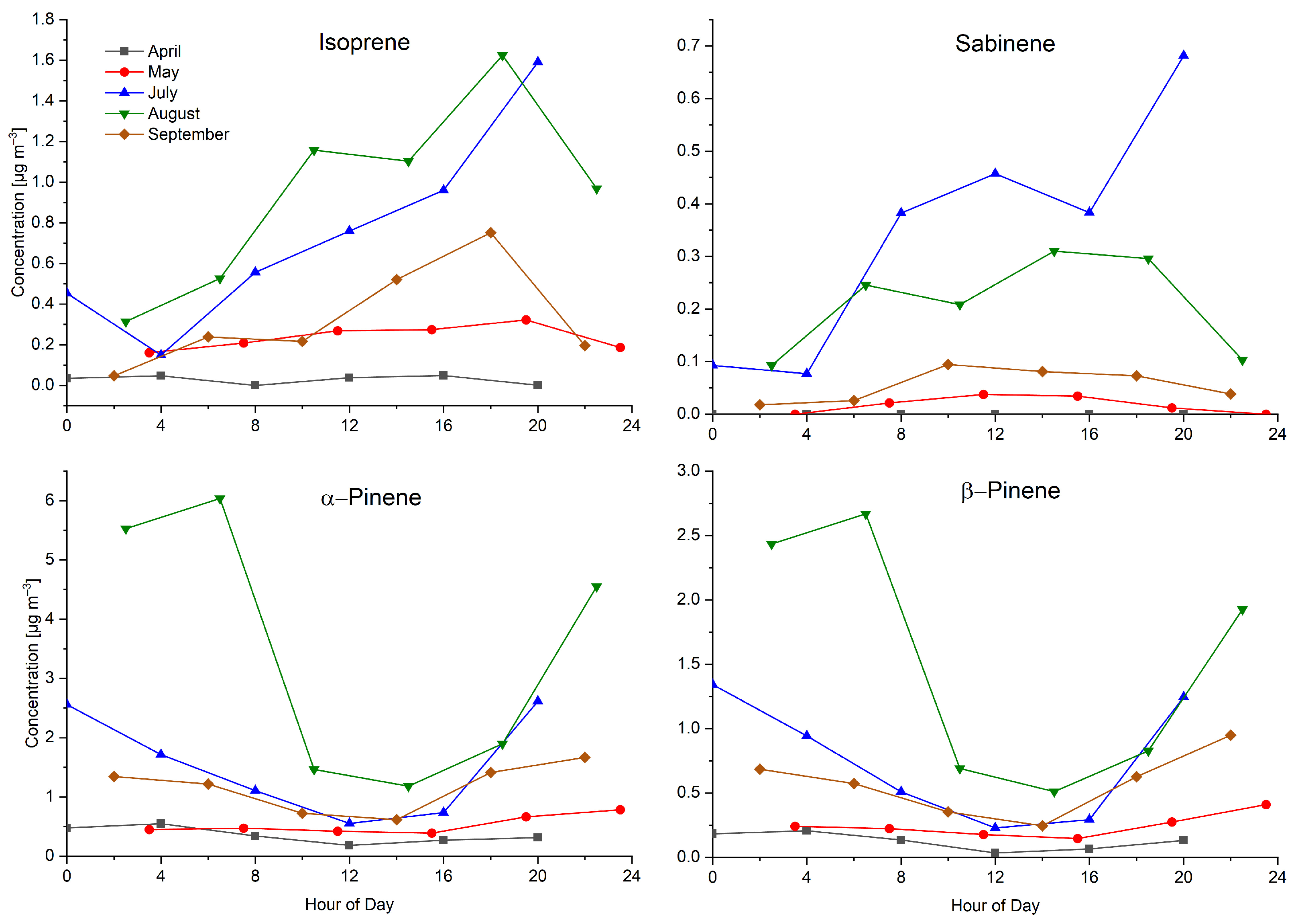

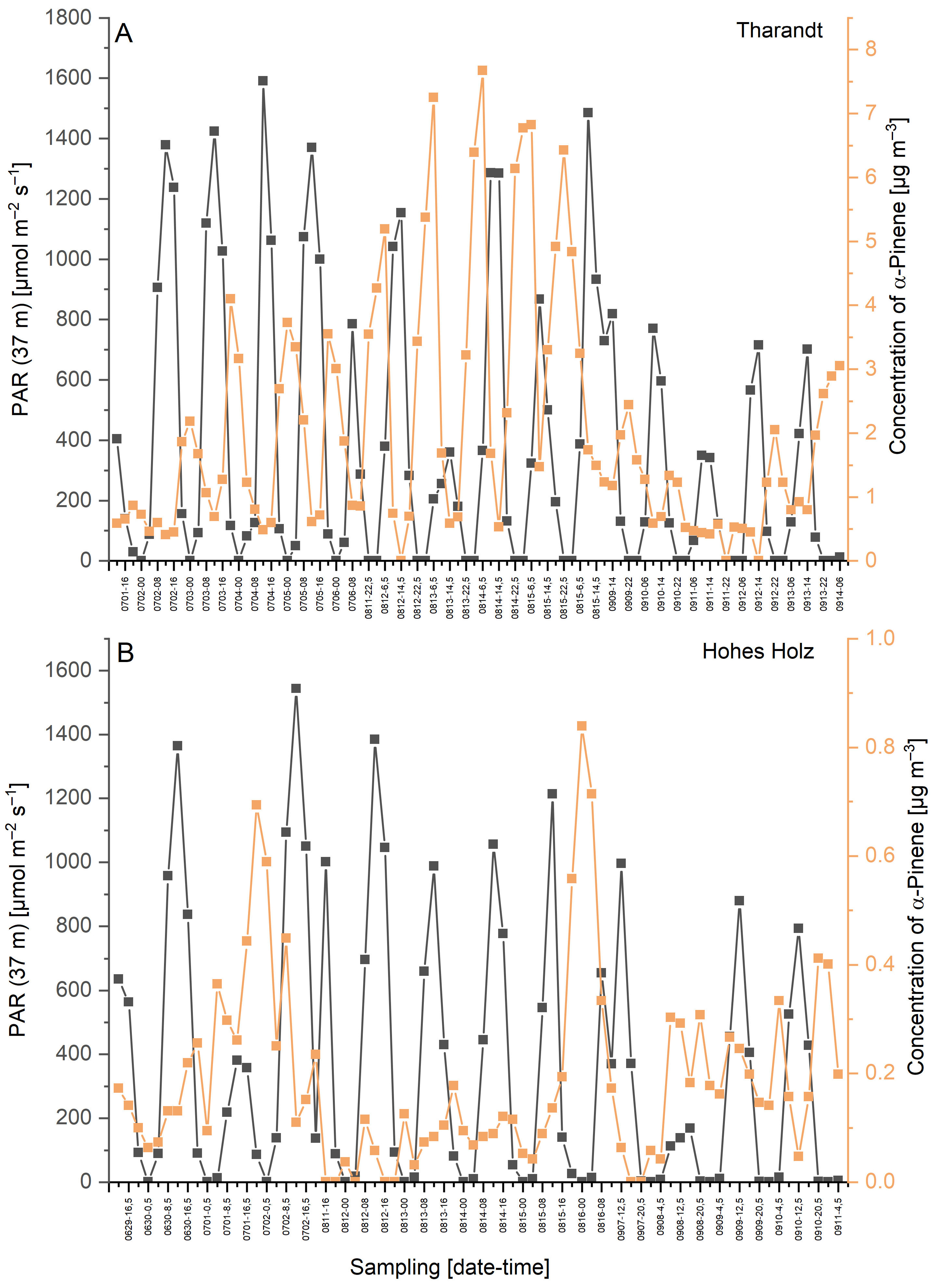

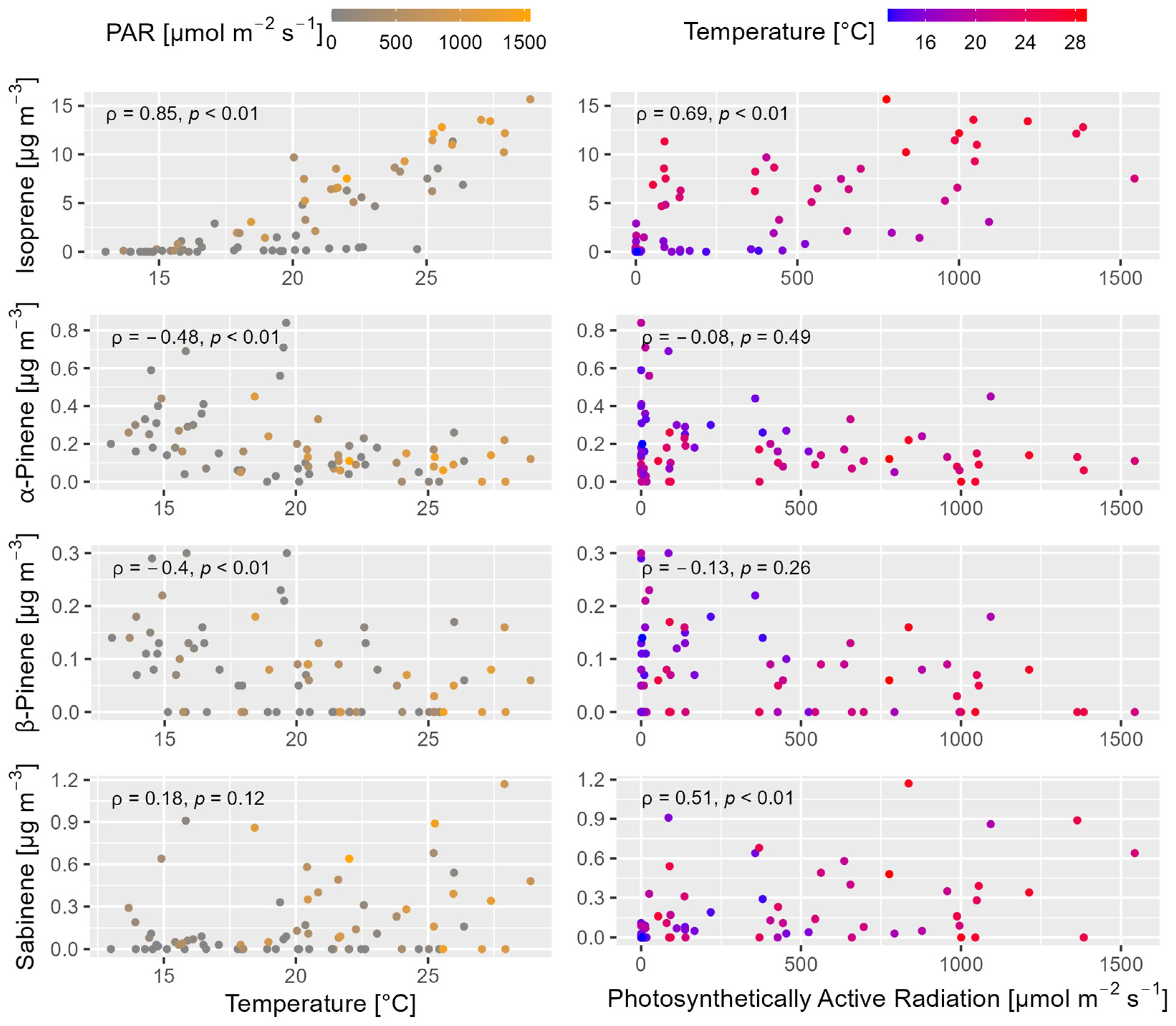
| Parameter | Isoprene | α-Pinene | β-Pinene | Sabinene |
|---|---|---|---|---|
| Concentration (µg m−3) | ||||
| Tharandt | ||||
| PAR (µmol m−2 s−1) 1 | ρ = 0.34, p < 0.01 | ρ = −0.28 p < 0.01 | ρ = −0.35, p < 0.01 | ρ = 0.31, p < 0.01 |
| Temperature (°C) | ρ = 0.85, p < 0.01 | ρ = 0.57, p < 0.01 | ρ = 0.50, p < 0.01 | ρ = 0.69, p < 0.01 |
| Relative humidity (%) | ρ = −0.77, p < 0.01 | ρ = −0.33, p < 0.01 | ρ = −0.24, p < 0.01 | ρ = −0.41, p < 0.01 |
| Ozone (µg L−1) | ρ = 0.46, p < 0.01 | ρ = −0.09, p = 0.271 | ρ = −0.16, p = 0.05 | ρ = 0.126, p = 0.14 |
| Windspeed (m s−1) | ρ = −0.19, p = 0.03 | ρ = −0.26, p < 0.01 | ρ = −0.24, p < 0.01 | ρ = −0.27, p < 0.01 |
| Soil temperature (°C) 1 | ρ = 0.33, p < 0.01 | ρ = 0.50, p < 0.01 | ρ = 0.50, p < 0.01 | ρ = 0.35, p < 0.01 |
| SWC (%) 1 | ρ = −0.67, p < 0.01 | ρ = −0.63, p < 0.01 | ρ = −0.06, p < 0.01 | ρ = −0.63, p < 0.01 |
| Hohes Holz | ||||
| PAR (µmol m−2 s−1) 1 | ρ = 0.69, p < 0.01 | ρ = −0.08, p = 0.49 | ρ = −0.13, p = 0.26 | ρ = 0.51, p < 0.01 |
| Temperature (°C) | ρ = 0.85, p < 0.01 | ρ = −0.48, p < 0.01 | ρ = −0.40, p < 0.01 | ρ = 0.18, p = 0.12 |
| Relative humidity (%) | ρ = −0.79, p < 0.01 | ρ = 0.55, p < 0.01 | ρ = 0.50, p < 0.01 | ρ = −0.09, p = 0.46 |
| Ozone (µg L−1) | ρ = 0.70, p < 0.01 | ρ = −0.09, p < 0.01 | ρ = −0.22, p = 0.07 | ρ = 0,15, p = 0.19 |
| Windspeed (m s−1) | ρ = 0.00, p = 0.97 | ρ = −0.21, p = 0.08 | ρ = −0.06, p = 0.61 | ρ = −0.07, p = 0.55 |
| Soil temperature (°C) 1 | ρ = 0.01, p = 0.92 | ρ = −0.11, p = 0.34 | ρ = −0.25, p = 0.03 | ρ = −0.19, p = 0.11 |
| SWC (%) 1 | ρ = −0.13, p = 0.25 | ρ = 0.40, p < 0.01 | ρ = 0.43, p < 0.01 | ρ = 0.32, p < 0.01 |
Disclaimer/Publisher’s Note: The statements, opinions and data contained in all publications are solely those of the individual author(s) and contributor(s) and not of MDPI and/or the editor(s). MDPI and/or the editor(s) disclaim responsibility for any injury to people or property resulting from any ideas, methods, instructions or products referred to in the content. |
© 2023 by the authors. Licensee MDPI, Basel, Switzerland. This article is an open access article distributed under the terms and conditions of the Creative Commons Attribution (CC BY) license (https://creativecommons.org/licenses/by/4.0/).
Share and Cite
Borsdorf, H.; Bentele, M.; Müller, M.; Rebmann, C.; Mayer, T. Comparison of Seasonal and Diurnal Concentration Profiles of BVOCs in Coniferous and Deciduous Forests. Atmosphere 2023, 14, 1347. https://doi.org/10.3390/atmos14091347
Borsdorf H, Bentele M, Müller M, Rebmann C, Mayer T. Comparison of Seasonal and Diurnal Concentration Profiles of BVOCs in Coniferous and Deciduous Forests. Atmosphere. 2023; 14(9):1347. https://doi.org/10.3390/atmos14091347
Chicago/Turabian StyleBorsdorf, Helko, Maja Bentele, Michael Müller, Corinna Rebmann, and Thomas Mayer. 2023. "Comparison of Seasonal and Diurnal Concentration Profiles of BVOCs in Coniferous and Deciduous Forests" Atmosphere 14, no. 9: 1347. https://doi.org/10.3390/atmos14091347
APA StyleBorsdorf, H., Bentele, M., Müller, M., Rebmann, C., & Mayer, T. (2023). Comparison of Seasonal and Diurnal Concentration Profiles of BVOCs in Coniferous and Deciduous Forests. Atmosphere, 14(9), 1347. https://doi.org/10.3390/atmos14091347








